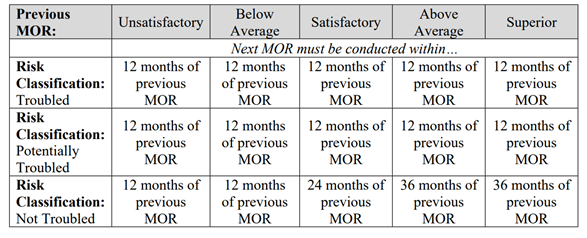HUD Implements Long-Awaited Risk-Based Schedule for MORs
On June 27, HUD published a final rule amending existing project-based Section 8 regulations related to Management and Occupancy Reviews (MORs), including for the Section 202/8 program. Effective 90 days after publication (September 26), MORs will be conducted on a performance-based schedule based on a property’s assigned risk level.
HUD is making this move to a performance-based MOR schedule to establish a risk-based scheduling protocol, reduce the frequency of MORs for projects that consistently perform well, and provide consistency across programs with respect to MOR frequency.
Currently, the various HUD programs subject to MORs have different rules for the frequency of MORs (some programs require CAs to perform MORs at least annually, while others require an MOR only as necessary). Current regulations also disregard property previous performance; according to the final rule, more than 94% of projects received a score of “Satisfactory,” “Above Average,” or “Superior” in Fiscal Year 2021. The new schedule will allow Contract Administrators to devote relatively fewer resources to higher-performing projects.
Risk-Based Property Classification
The new MOR schedule establishes a frequency for the completion of MORs based upon a project’s previous MOR score and the project’s rating under HUD’s risk-based asset management model. To determine each project’s risk rating, HUD’s asset management model incorporates both qualitative and quantitative elements into a comprehensive property-level rating. This rating translates to a risk-based classification of “Troubled,” “Potentially Troubled,” or “Not Troubled.”
HUD’s asset risk-rating process uses an objective scale that considers financial characteristics (e.g., low debt service coverage ratio (DSCR)), recent occurrences (e.g., default, excessive vacancies, low Real Estate Assessment Center’s (REAC) score), tenant input (as assessed during MORs and as provided directly to HUD), and pending transactions with HUD (e.g., foreclosure, partial payment of claim):
- For insured projects: the likelihood of a claim within 12 months or sooner; whether a partial payment of claim or debt restructuring is in process; the project’s Qualitative Assessment Score, which takes into account qualitative factors such as tenant complaints and local code violations; the project’s vacancy rate, debt service coverage ratio, Real Estate Assessment Center (REAC) score; whether, for a new construction project, underwriting assumptions have been met.
- For non-insured projects: whether a HAP termination or foreclosure is pending; whether a transfer of budget authority or of HAP, debt, and use restrictions is in process; whether a change in ownership is required; whether the project has problems that make it eligible for a conversion to Housing Choice Voucher assistance that has not yet begun; the project’s vacancy rate, REAC score; whether the project is in compliance with any applicable use agreement.
More information about HUD’s risk rating system, including a HUD checklist to determine each property’s risk classification, is available for LeadingAge members here.
New Performance-Based MOR Schedule
The proposed performance-based MOR schedule considers both a project’s risk-rating and its MOR score to establish whether the project’s next MOR will be scheduled within 12, 24, or 36 months of the previous MOR; the scheduled approach is similar to HUD’s physical inspection protocol through REAC, which HUD is simultaneously seeking to enhance.
- A project must have an MOR within 12 months of its previous MOR if
- (a) it has a risk classification of “Troubled” or “Potentially Troubled” without regard to its MOR score, or;
- (b) it has a risk classification of “Not Troubled” and an MOR score of “Unsatisfactory” or “Below Average”
- A project must have an MOR within 24 months of its previous MOR if it has a risk classification of “Not Troubled” and an MOR score of “Satisfactory”
- A project must have an MOR within 36 months of its previous MOR if it has a risk classification of “Not Troubled” and a previous MOR score of “Above Average” or “Superior”

Schedule Implementation
The new schedule will apply to all project-based Section 8 projects, regardless of whether the contract is administered by a PBCA, HUD, or a Traditional Contract Administrator. However, Section 519(b)(1) of MAHRA requires CAs to monitor the status of projects renewed under Mark-to-Market at least annually. Therefore, the new schedule does not apply to restructured Mark-to-Market properties.
In implementing the performance-based MOR schedule, HUD will establish a time frame for each project’s next MOR at the first MOR following the effective date of this final rule. Based upon a project’s MOR score following that first MOR and the project’s risk rating at the time, HUD will determine the date of each project’s next MOR according to the performance-based MOR schedule.
The new rule also requires that an MOR be performed within 6 months following a change in ownership or management irrespective of a project’s performance-based MOR schedule. The rule follows the January 14, 2015, publication of a proposed MOR schedule, on which HUD sought public comments.

Most Recommended
July 03, 2025
 Budget Reconciliation 2025
Budget Reconciliation 2025
July 08, 2025
Pathways for Foreign-Born Workers
Recently Added
July 09, 2025



